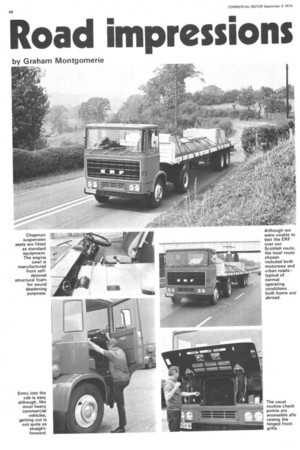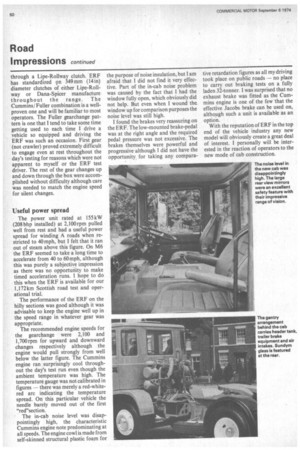Road impressions
Page 50

Page 51

Page 52

If you've noticed an error in this article please click here to report it so we can fix it.
by Graham Montgomerie
Trying the B-series ERF 32-ton tractive unit with Cummins engine on normal roads and motorways
AS DESCRIBED on the preceding pages the new B-series range from ERF is announced today. When some weeks ago the opportunity came to test the prototype unit it was our intention to take it over our Scottish test route, but some first-model teething troubles with the transmission prevented this so a shorter trial was run around the roads and motorways of Cheshire.
The first thing that caught my eye when climbing into the cab was the presence of a light shining onto the steps when the door is opened. A useful idea. The cab is well laid out from the point of N4ew of driver vision, especially the histrument panel which is dominated by the European-type tachograph with its major scale calibrated in kilometres per hour. This feature caught me out during the first five minutes at the wheel because, by not reading the instruments carefully enough, I thought I was doing 40mph in a 30 mph limit when the actual road speed was 40 km/h.
The Chapman suspension seat is fully adjustable in all the usual planes and is upholstered in cloth. This seat material was certainly appreciated on the day I drove the new ERF When the weather was extremely hot. One aspect of the seating position which I did not like was the raised portion of the cushion.along the front ridge of the seat. This meant that I had to have the seat slightly lower than I would have preferred in order to maintain a comfortable position relative to the pedals.
The pedals themselves were first class. It seems that at long last.somebody has consulted the driver over the height and angle of the pedals, which makes a pleasant change. For example, the clutch pedal is low-mounted with a relatively short travel of around five inches, • which was far easier to use than the usual high-mounted controls with a longer travel. When I use the word "usual" I am not singling out the earlier ERFs as the only example of poor pedal layout. Most manufacturers in the maximum-capacity field have been guilty of this at some time or another.
Unusual throttle
The throttle is rather unusual in that the actual pedal pad pivots about on the top of the linkage, which allows the driver to maintain a comfortable position on the pedal whether he is running at full or part throttle. Full marks to ER F for the pedal assembly although perhaps the throttle pedal spring strength was on the high side.
Having praised one area of the new truck I am now going to criticize another. On the new B-series the stalk controls on the steering column are too far away for comfortable operation. In fact the right-hand stalk controlling the direction indicators, horn and headlight flash! dip cannot be reached with the hand on the steering wheel. I found it necessary to reach down in a separate movement for this lever — it was impossible to "flick" it with the finger tips in the normal manner.
The forward visibility from the new cab is reasonable but not exceptional for this class of vehicle, with some intrusion by the frame pillars into the field of vision. But the enormous rear-view mirrors gave an excellent scan to the rear and were a real safety feature.
Starting the Cummins engine was achieved with the key alone, no separate start button behing used. Stopping it was the reverse procedure — turning the key anti-clockwise activated an electrically operated solenoid for the engine stop, although this took a longer time than usual to take effect.
The instrument panel has two flashing "idiot lights" designed to attract the driver's attention to his other instruments. Taking the cab lock mechanism as an example, if the lock was not completely secure these twin warning lights would flash — scanning the instrument panel would reveal the illuminated cablock light which will not go out until the mechanism is completely secure. This same procedure applies to the parking brake, oil pressure, etc.
On the road the ERF handles well. I tried the tractive unit on its own as well as in the fully laden 32-ton-gcw form and I was pleasantly surprised at the lack of bounce in the unit. When coupled to a York tandem-axle semitrailer the total combination was easy to handle on winding Cheshire roads. On average road surfaces the ride was reasonable but, on very bumpy sections, I felt the induced cab-nod was excessive. The ride on the smoother sections of motorway was very good.
One aspect of the ERF's ride characteristics which showed up well was its behaviour on roads with long undulations rather than small bumps. Quite often a truck tends to get in frequency with these undulations, with the result that the ride rapidly deteriorates even though the road surface would be described as "smooth".
The Cummins NH220 engine was coupled to a Fuller RTO 9509 gearbox through a Lipe-Rollway clutch. ERF has standardized on 349 mm (141n) diameter clutches of either Lipe-Rollway or Dana-Spicer manufacture throughout the range. The Cummins/ Fuller combination is a wellproven one and will be familiar to most operators. The Fuller gearchange pattern is one that I tend to take some time getting used to each time I drive a vehicle so equipped and driving the ERF was such an occasion. First gear (not crawler) proved extremely difficult to engage even at rest throughout the day's testing for reasons which were not apparent to myself or the ERF test driver. The rest of the gear changes up and down through the box were accomplished without difficulty although care was needed to match the engine speed for silent changes.
Useful power spread
The power unit rated at 155 kW (208 bhp installed) at 2,100rpm pulled well from rest and had a useful power spread for winding A roads when restricted to 40 mph, but I felt that it ran out of steam above this figure. On M6 the ERF seemed to take a long time to accelerate from 40 to 60mph, although this was purely a subjective impression as there was no opportunity to make timed acceleration runs. I hope to do this when the ERF is available for our 1,172km Scottish road test and operational trial.
The performance of the ERF on the hilly sections was good although it was advisable to keep the engine well up in the speed range in whatever gear was appropriate.
The recommended engine speeds for the gearchange were 2,100 and 1,700 rpm for upward and downward changes respectively although the engine would pull strongly from well below the latter figure. The Cummins engine ran surprisingly cool throughout the day's test run even though the ambient temperature was high. The temperature gauge was not calibrated in figures — there was merely a red-whitered arc indicating the temperature spread. On this particular vehicle the needle barely moved out of the first "red"section.
The in-cab noise level was disappointingly high, the characteristic Cummins engine note predominating at all speeds. The engine cowl is made from self-skinned structural plastic foam for the purpose of noise insulation, but I am afraid that I did not find it very effective. Part of the in-cab noise problem was caused by the fact that I had the window fully open, which obviously did not help. But even when I wound the_ window up for comparison purposes the noise level was still high.
I found the brakes very reassuring on the ERF. The low-mounted brake-pedal was at the right angle and the required pedal pressure was not excessive. The brakes themselves were powerful and progressive although I did not have the opportunity for taking any compara tive retardation figures as all my driving took place on public roads — no place to carry out braking tests on a fully laden 32-tonner. I was surprised that no exhaust brake was fitted as the Cummins engine is one of the few -that the effective Jacobs brake can be used on, although such a unit is available as an option. With the reputation of ERF in the top end of the vehicle industry any new model will obviously create a great deal of interest. I personally will be interested in the reaction of operators to the new mode of cab construction.


























































































































































